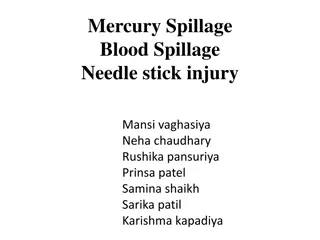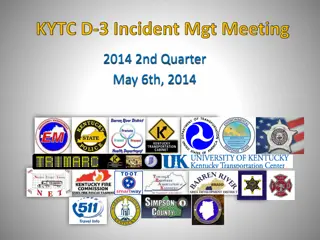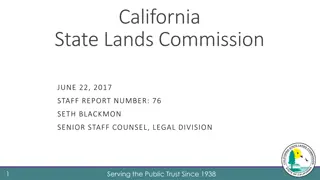Spill Control and Cleanup Procedures for Chemical Incidents
Learn the essential steps to control and clean up spills from chemical incidents, starting with turning off the engine and using absorbent materials to contain and remove the spill safely. Proper disposal of the contaminated materials is crucial, and communication with relevant parties is key in handling emergency situations effectively.
Download Presentation

Please find below an Image/Link to download the presentation.
The content on the website is provided AS IS for your information and personal use only. It may not be sold, licensed, or shared on other websites without obtaining consent from the author. Download presentation by click this link. If you encounter any issues during the download, it is possible that the publisher has removed the file from their server.
E N D
Presentation Transcript
S. Alan Harlan, ACE 2 Hours WDO
Unlinednitrile, latex, or rubber gloves NIOSH respirator and cartridges Safety glasses or goggles Plastic bags Soak Up Detergent Snakes Broom Dustpan Paper towels
I hope that this is not something that reminds anyone of a spill from a termite pumping unit.
How do you control the spill? Start with turning off the engine. Reduce the amount that has to be cleaned up.
Limit the distance that the spill has travelled by damming it with an absorbent snake. Sprinkle the loose absorbent over the spill. Remember, 1 lb. of absorbent will soak up 11 gallons. Wait until the absorbent has turned to a clear gelatinous sludge.
Now clean up the absorbent material. How should you dispose of the contained spill at this point?
Dusts, Granules, Termite Bait, and Rodenticide should be swept thoroughly and placed in a plastic bag. Label the bag with pertinent information: Product Date Location Technician
Let someone know Preferably after the spill has been cleaned-up
Are you ready for a spill? Have you thought about what you might do in the event of a spill? Let s divide into small groups and discuss The following potential situation. What would you do if you were asked to assist?
A technician loses control of the service vehicle and is unconscious and severely injured. You are contacted by the emergency response team And advised that there is a small leak originating from around the pump.
If the driver is unconscious, who at your company is the emergency contact? Can you walk the HAZMAT/Emergency Response Team through containing a spill over the phone? Do you KNOW what material has been spilled? Do you have SDS for each product that s used at your company?
Use A Mobile SDS app that enables you to immediately send a current SDS to the appropriate party. Ensure that everyone at your company KNOWS who to contact in the event of an emergency. Response time is critical. Know where each spill kit is kept on each vehicle. Behind the driver s seat is a great spot. Don t keep the spill kit in the toolbox or where products are stored. Regularly check spill kit for contents and ensure that the soak up material hasn t hardened. Monthly when counting inventory is a great time to check. You don t want to find out that you don t have enough Soak Up when you need it most or when you are stopped by AG for a truck inspection. Most importantly- Make sure that everyone is OK.
A technician attempts to make a u-turn across a four lane highway. The vehicle is struck in the side by an oncoming motorist, dislodging the termite pumping unit and cracking the tank. It causes a spill. You are asked to assist.
Is the driver OK and able to lend aid in the clean up? Are the passengers in the other vehicle OK? Keep everyone away from the site of the spill. If possible, mark the area where the spill is located with crime scene tape. How do you direct the spill cleanup if you are unavailable?
If you are the one responsible for spill cleanup oversight, it s important to have several backup people in place to fill in when you re not available. EVERYONE should have a spill kit and should be able to competently lend aid in the event of an emergency. Mock spills/Practice should be periodically conducted to improve competency. Annual fit testing can be conducted concurrently with spill control/Hazmat training.
A technician has just completed a residential pre-treat and is attempting to leave when his vehicle catches fire and engulfs the termite pumping unit, melting part of the top. The fire is extinguished and a tow truck is on the way. It is not possible to tow without a large quantity of the solution spilling. The technician calls you and wants to know how he should proceed.
Bad stuff happens on Friday afternoon! Drop everything and drive out to the site Fire Extinguishers for all vehicles is a good idea Look for creative solutions.
You are treating a back patio when you suddenly lose pressure. Thinking that the tank is empty, you head back to the vehicle to refill it. Arriving at the truck, you see liquid shooting in the air around the hose reel. You are parked on the street on a slope. The rear of your truck faces the middle of a cul de sac with a storm drain which leads to a neighborhood lake.
What happens if it rains while Im cleaning up? Is bleach an appropriate part of the clean up process?
Hose clamps dont last forever. Hose Clamps cost as little as $.40 and as much as $40- replace periodically. The best time to learn where a spill kit is located and whether all items are present is not when a spill is occurring. The best time to train a new employee on the merits of spill control is not when an actual spill is occurring. Locate storm drains, wells, and easements prior to performing work. Should new employees have phones issued on day one in the event of an accident?
Proper Preparation Prevents Practice Be Consistent- Inspect Kits regularly for location and contents Consistently look for ways to prevent spills from happening. Keep additional PPE in the spill kit
S. Alan Harlan, ACE 2 Hours WDO























